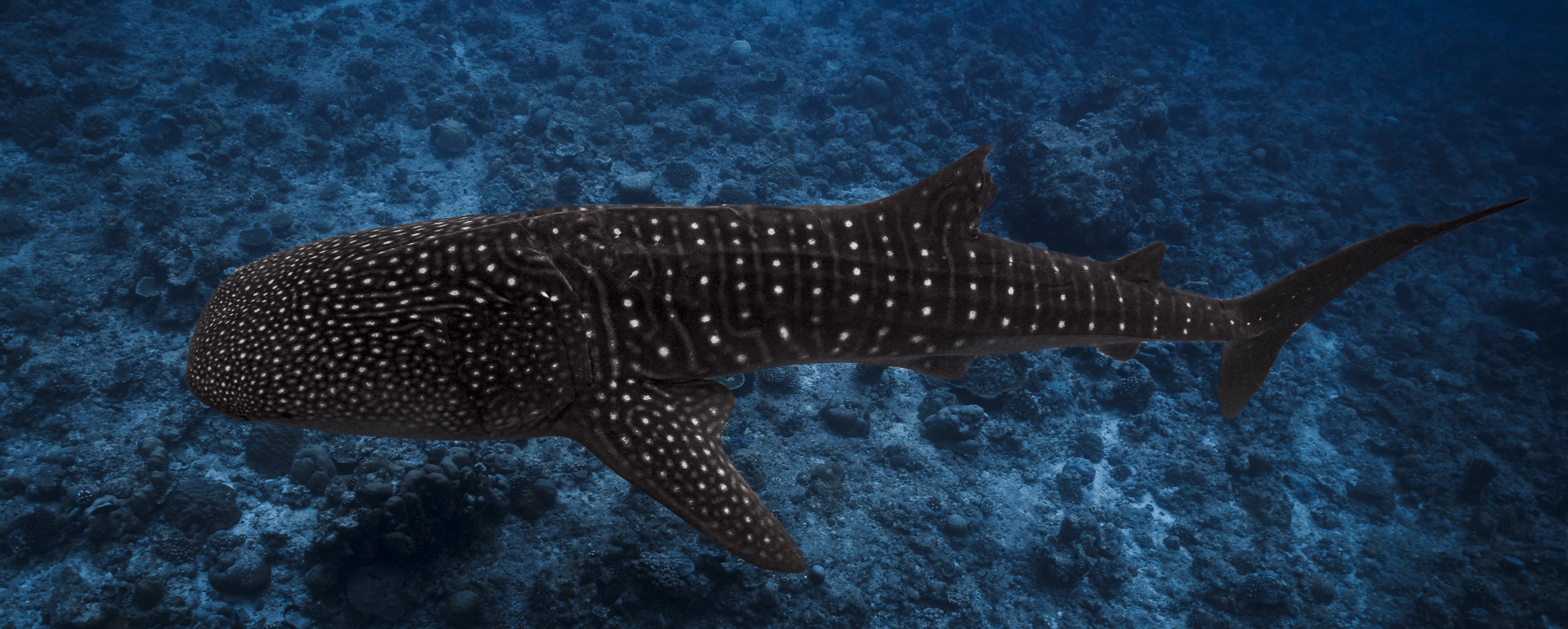
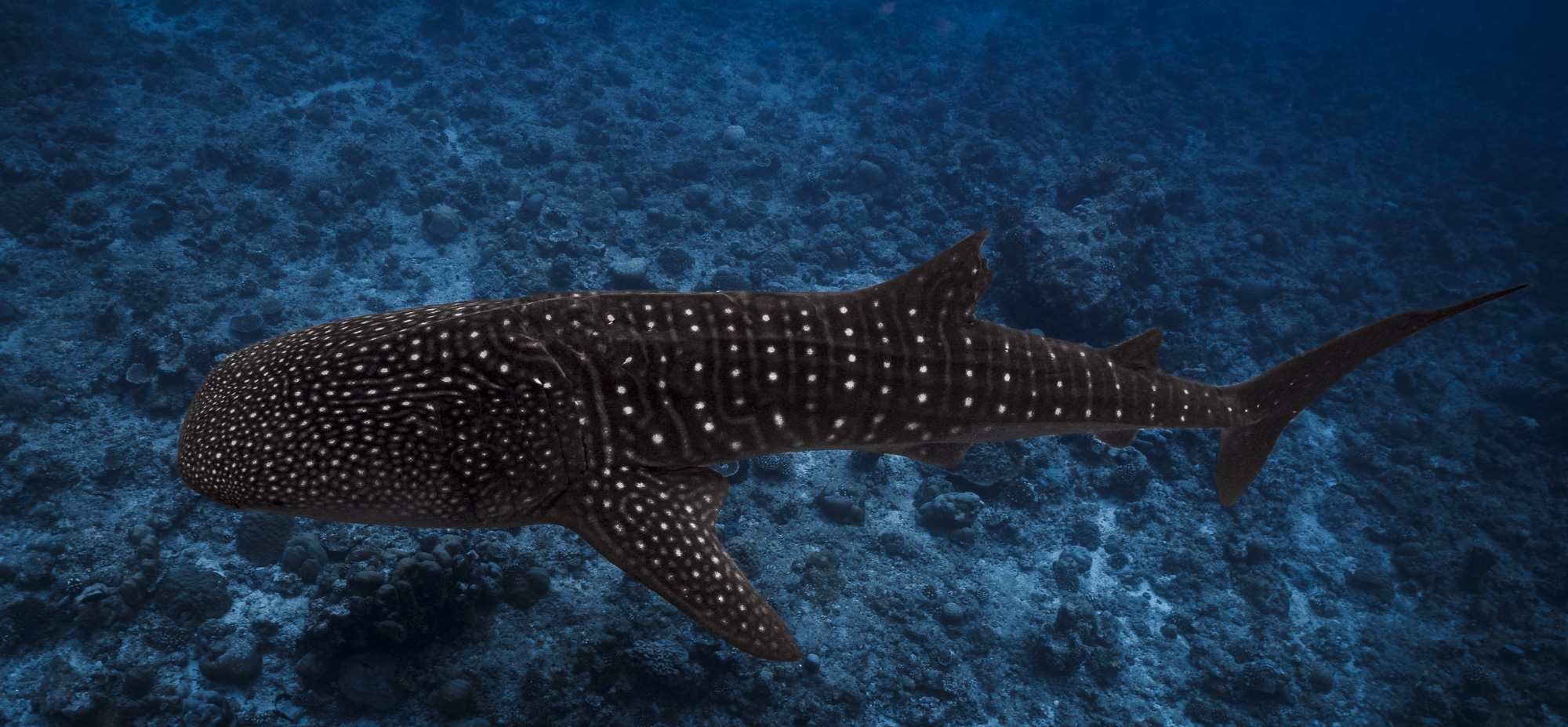
How we supported whale shark research on the Maldives
How did we get into it?
Since we went diving for the first time, the sea has become our absolute favorite place and the underwater world has fascinated us more and more with every dive. It is therefore hardly surprising that most of our trips are diving trips. We have tried everything from day trips to liverboard tours. We have had very different experiences with the various tour operators. Some focused on fun, others were particularly focused on the safety of the divers and still others just wanted to “satisfy” as many tourists as possible in the shortest possible time. Of course, we welcome great importance to safety and there is nothing wrong with having fun while diving. But on most tours one aspect was often neglected: marine conservation!
We saw destroyed reefs, corals wrapped in fishing nets, sharks whose fins had been cut by boats and tourists who harass or even enthusiastically touch marine animals. All of this was rarely discussed on the tours. Floating plastic was all too often ignored instead of being collected. And hardly any operator talked about the fact that tourism can also be harmful to the dive sites if it’s done carelessly. In particularly bad cases, we even saw dive guides themselves intentionally scaring or harassing the marine animals.
Of course, there were also very good guides and most of them only have good intentions. However, these experiences made us want to do our diving trips differently and so we looked for alternatives to the usual/conventional tour operators.
When we finally came across the Maldives Whale Shark Research Programme (MWSRP), we knew straight away that this was exactly the kind of trip we were looking for.
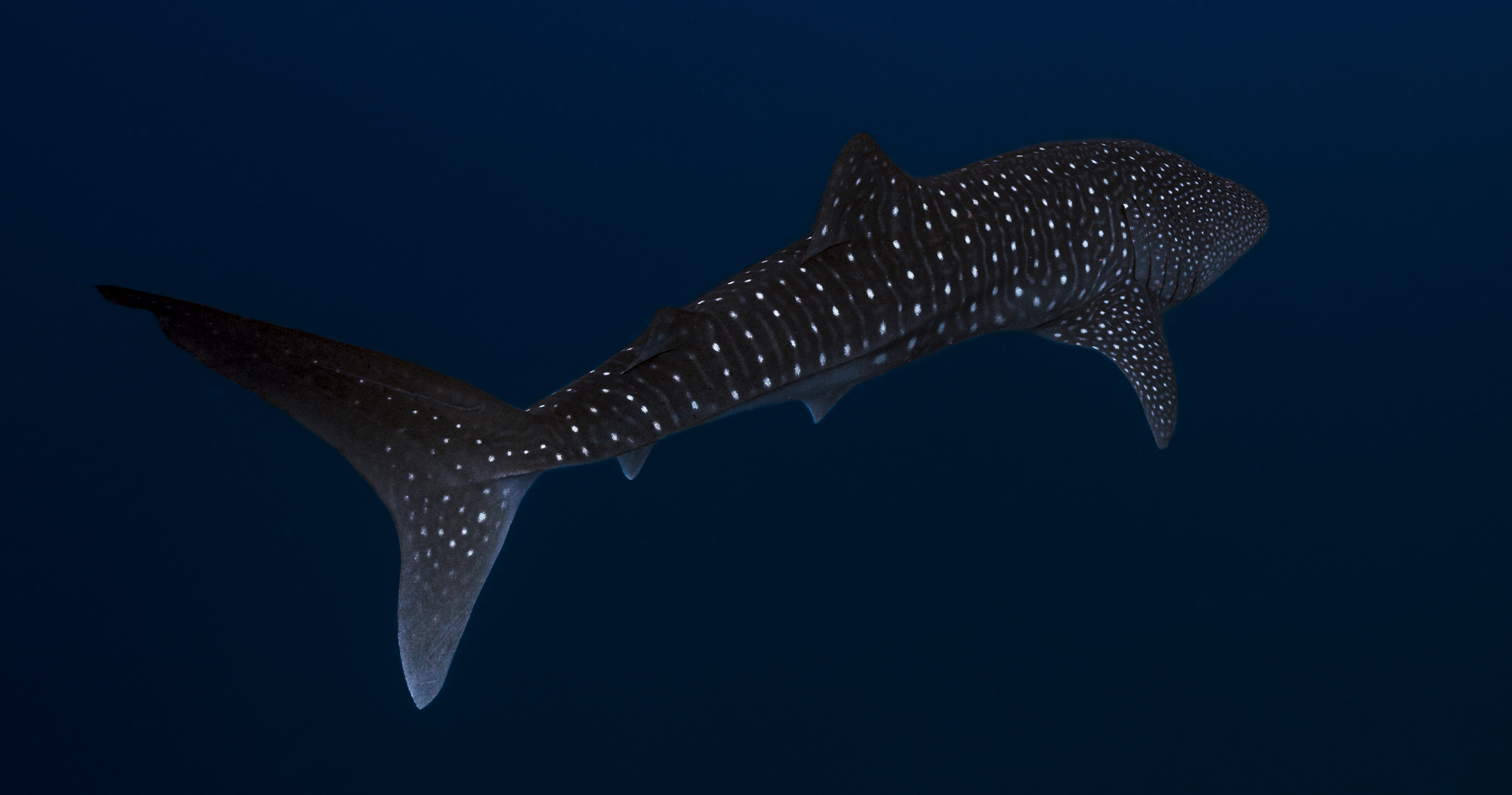
What exactly is the MWSRP?
The research programme is about collecting data on whale sharks in the South Ari Marine Protected Area (SAMPA) and processing it scientifically, for example by conducting studies on long-term observations. SAMPA is a marine area along the South Ari Atoll in the Maldives that has been protected since 2009. The 42 km long area stretches from the north-western end of the reef off Rangali Island to the north-eastern end of Dhigurah Island. It has been known for years as a hotspot for whale shark sightings, as it is a kind of second kindergarten or recreational area for juvenile whale sharks.
As a result, MWSRP has made it its mission to identify and catalog the whale sharks found in SAMPA using photo ID and to record other relevant data and environmental factors when the animals are sighted (more on this below). Another very important aspect of their work is to strengthen conservation policy in the Maldives and to engage and teach local people and industry through education and outreach.

What were the days like as volunteers?
Part of the program is to give volunteers the opportunity to accompany them for 10 days, support them in their work and learn from them. That sounded like the jackpot to us. Not only do we have the chance to see the megafauna that we love, but we also have the chance to make a contribution to nature conservation and science. So we applied for April 2024 and could hardly believe our luck when we received positive feedback. We have never been so excited about a trip as we were about this one!
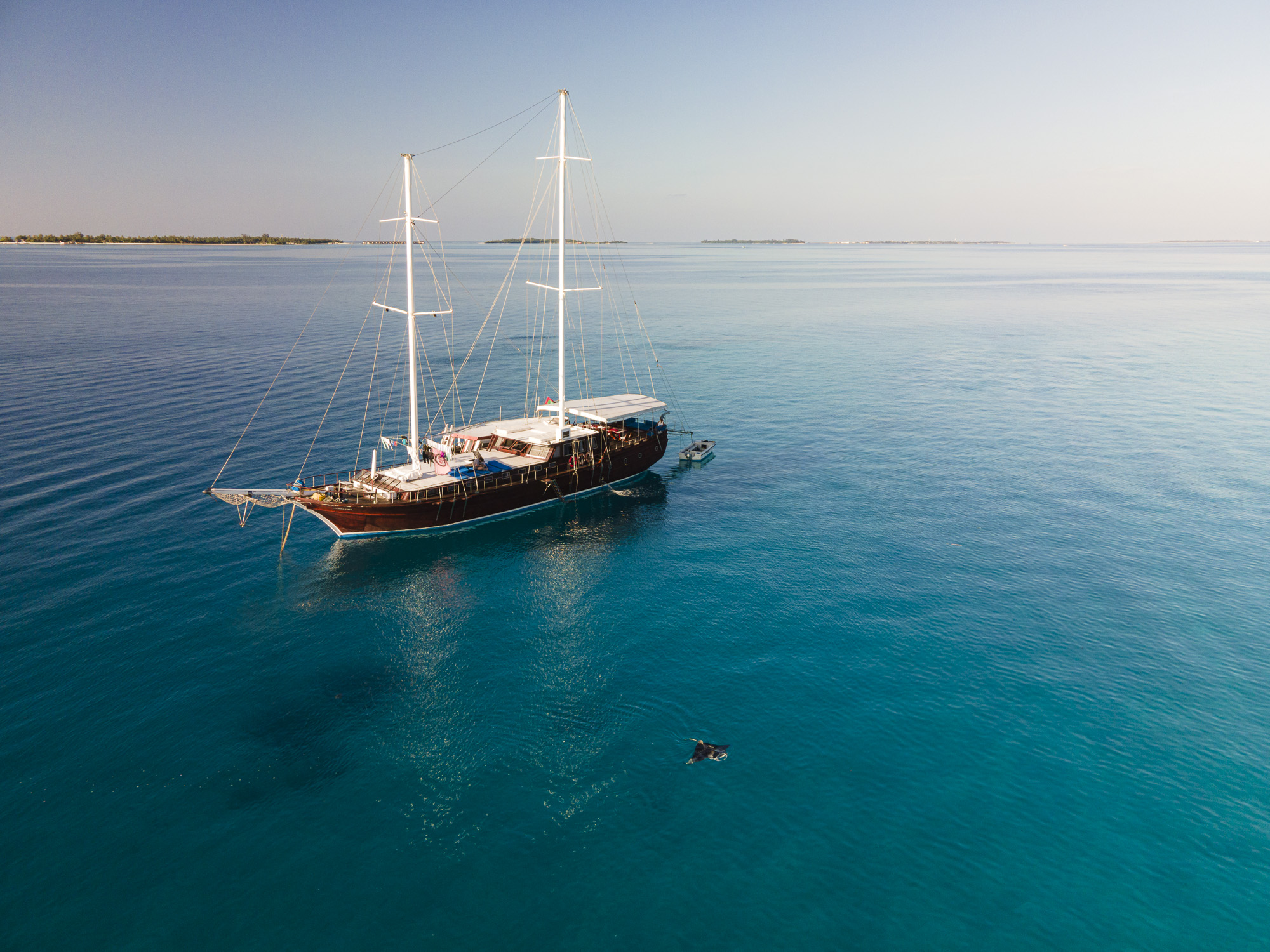
The big day of arrival came and it all started with us meeting the other volunteers at the airport. There we were met by Clara and Chloe, the two leaders of the tour. We went straight to a Maldivian boat, a so-called dhoni, which took us to our mother boat and made our way to the South Ari Atoll. A few minutes after we set off, the sea greeted us with a large pod of spinner dolphins, who put on a little show for us. The trip took about 6 hours. Since we only arrived after dark, the surprise of our new home for the coming days was even greater the next morning: We anchored right on the edge of one of the most beautiful reefs. Crystal clear, turquoise water surrounded us and apart from a few very small islands in the distance, there was nothing but water around us. And as if this place wasn’t already perfect, every morning reef manta rays came directly to our “house reef” and let us swim with them, as large amounts of plankton accumulated around our boat.
On the first evening we received a briefing about the program and how the coming days would go. It quickly became clear that this was not just a fun event and that the days would be exhausting. Every morning at 7:30 a.m. there was breakfast and our working day began at 8:30 a.m. We went out to the SAMPA in our dhoni and there we drove up and down for the next 8-9 hours, constantly looking for whale sharks. Our group of volunteers consisted of 12 people. Half of the group always had to look out for the animals on the roof of the dhoni, while the other half could recover one floor below from the merciless heat of the sun. At lunchtime we usually cooled off with a snorkeling tour along the reef and ate lunch on the dhoni.
For the first few days, luck stayed away from us and apart from other marine life such as turtles or rays, whose coordinates we recorded, there were no sightings of whale sharks. In addition, we often collected plastic waste from the sea whenever we saw ghost nets or larger pieces of plastic. We also saw tour boats all the time and in large numbers. We encountered everything from diving schools to snorkeling trips to large liveaboards. And here too we recorded important data such as the coordinates, the number of people on them, whether they were racing over the reef and who the operators were. Because the presence of many vehicles on the water, how they behave and the simultaneous absence of whale sharks can also be a relevant statement for science in the marine reserve.
Our first whale shark – our first identification
It was only on the 4th day that luck was with us. We saw our first whale shark! We were in the group taking a break and resting, our eyes were about to close when we suddenly heard strong, insistent stamping of feet from above. Then the calls. A whale shark was spotted. And from one second to the next we were in motion. We quickly slipped into our clothes and grabbed our cameras. In the water we had to flap our fins vigorously to get to the animal. And one thing became immediately clear to us at that moment: even world-class swimmers can’t compete with these big fish if they want to – and we certainly can’t. For this reason, our encounter was rather short-lived. This is not uncommon: Most encounters with whale sharks only last a few minutes, so this was not unusual.
The primary goal of a sighting is to identify the animal. To do this, at least one side, preferably both, of the shark must be photographed. The section between the end of the side fin and the last gill is important. This photo is then uploaded to a database in the evening and the most distinctive points of the animal in the section are manually traced. The program then searches the database for exactly this pattern. Because: The dotted pattern of whale sharks is always unique, similar to our human fingerprints.
A pattern as unique as a fingerprint.
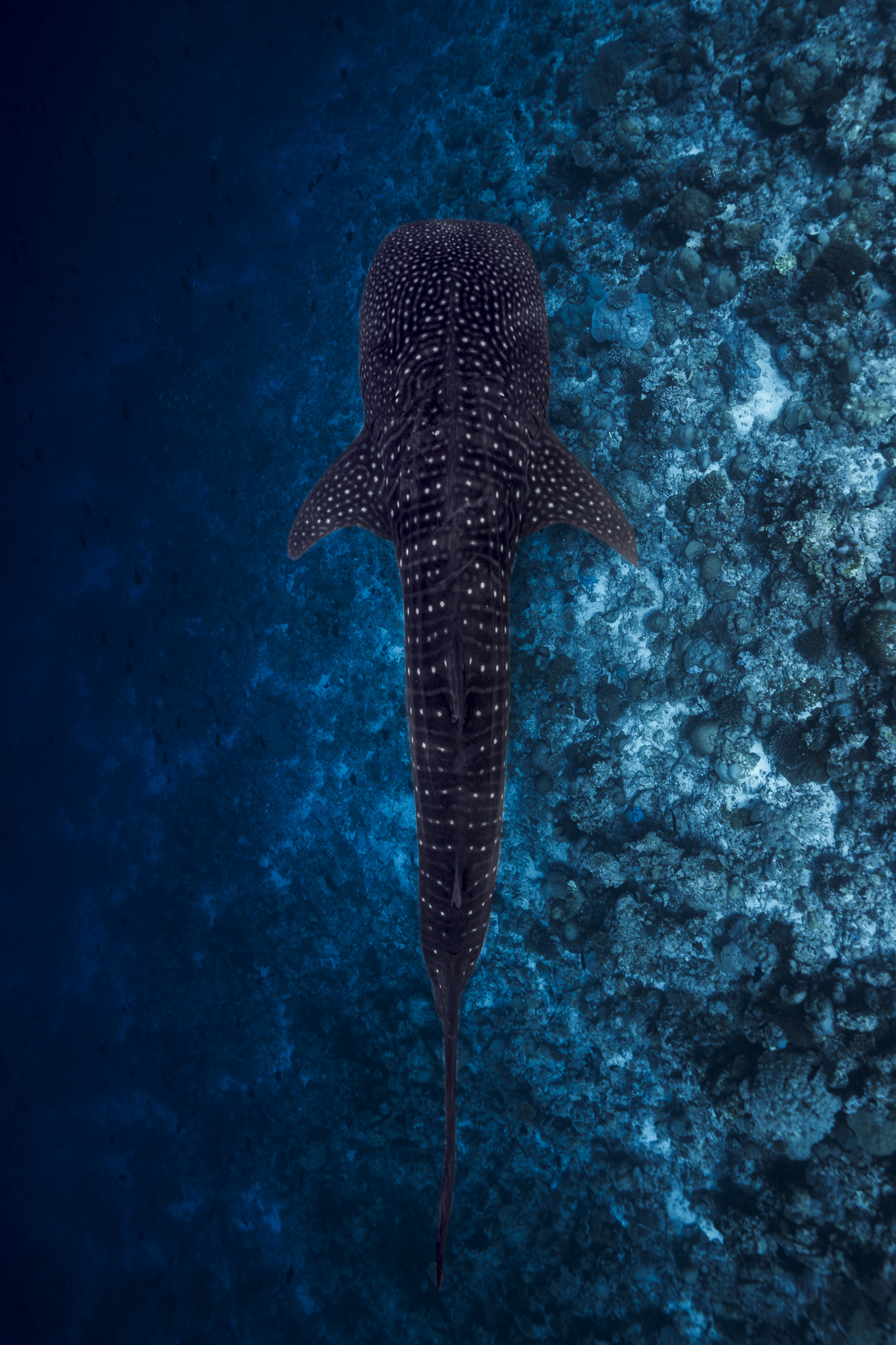
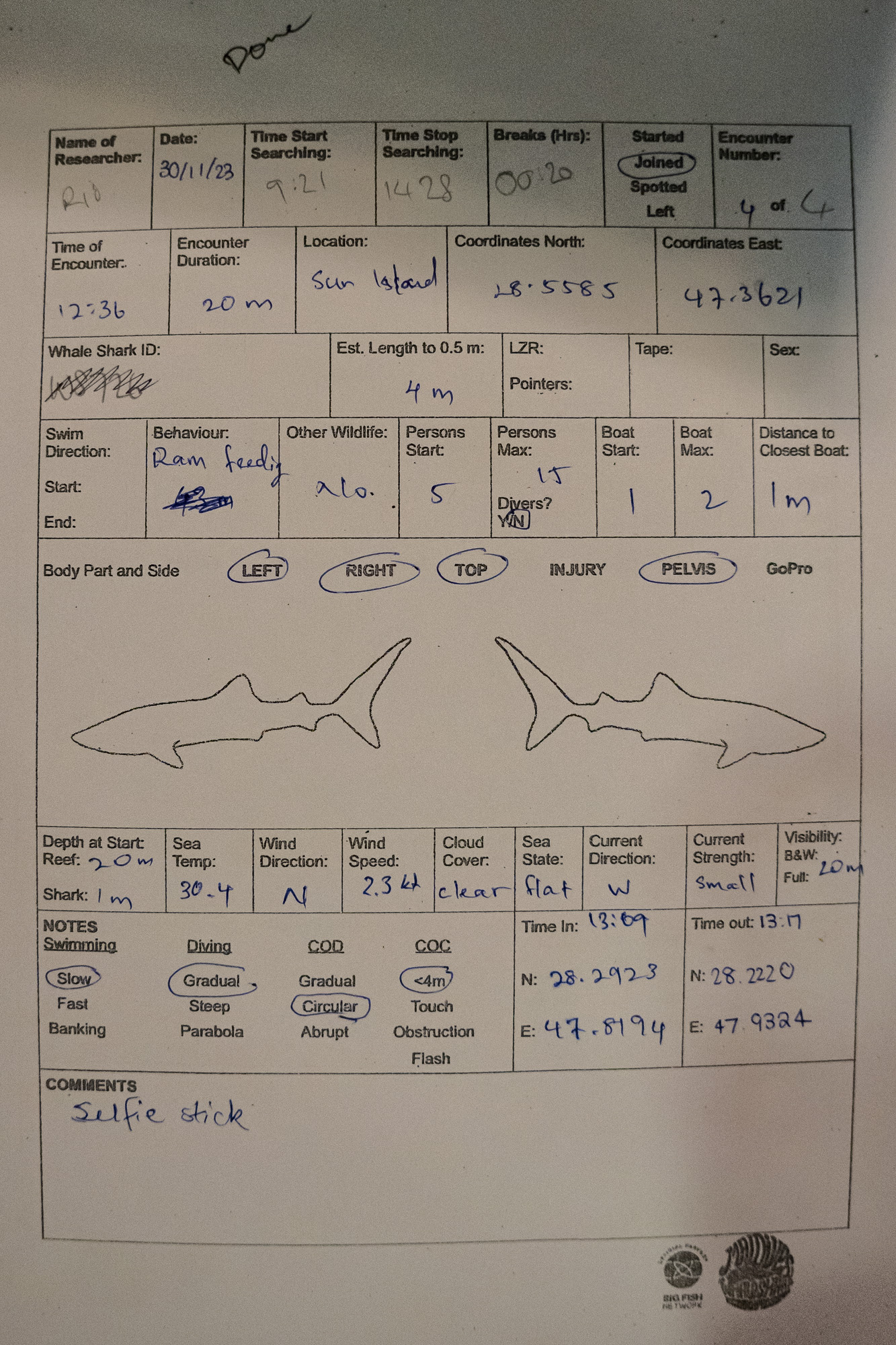
In particularly favorable circumstances, additional photos are taken from below (to determine the sex), from above and from the second side. However, the animal is the first priority. If it shows evasive or shy behavior, the additional photos are omitted. In particular, the shot from above may only be taken when the whale shark is already diving again.
In addition to identification, the program also deals with other relevant data that must be recorded. This means that after we have taken our photos and the whale shark has swum away, the coordinates of the sighting, the water temperature, wind strength and direction, the direction of the current and the visibility underwater must be recorded immediately. Further on, as many notes as possible are made about the animal’s behavior and the external circumstances.
In terms of behavior, a distinction is made between different feeding behaviors, relaxed swimming, curious, interactive, unnatural or evasive behavior, fast swimming and abrupt turns, tilting and retraction of the eyeballs. The last four behaviors in particular are to be interpreted negatively and mean that the animals feel uncomfortable or harassed. They are a clear sign that people should withdraw more in these situations in order to keep enough distance and thereby give the animal more space.
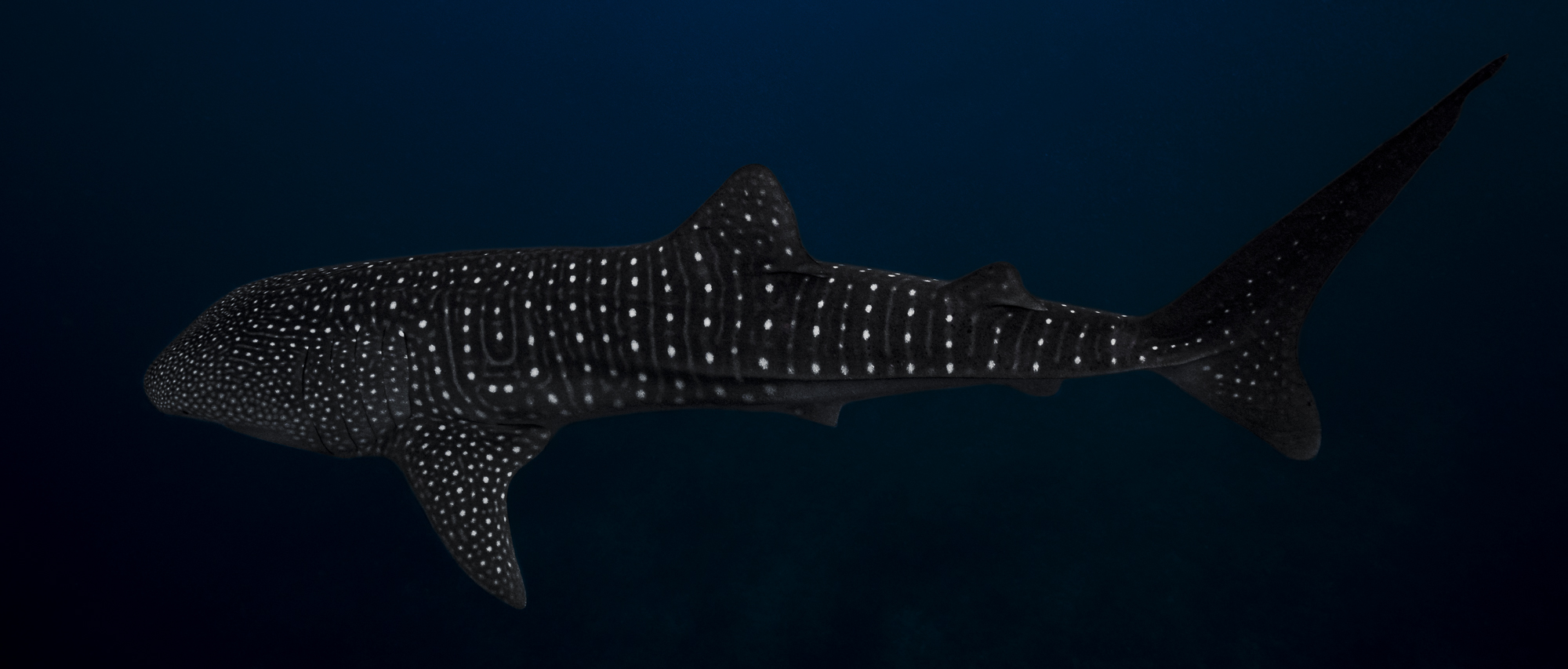
How does the work help to protect the animals?
For example, if several tour operators are on site at the same time and all of their guests want the chance to see the big fish, this can quickly lead to the guests getting too close to the animal. Unfortunately, it also happens again and again that uninformed people even try to touch the animals. This puts the whale sharks under enormous stress, as they urgently need the time at the surface to raise their body temperature again. Whale sharks can dive hundreds of meters deep and stay there for a long time, but they are dependent on returning close to the surface afterwards. This is because whale sharks are ectothermic, which means that their body temperature is roughly the same as the temperature of the water around them and they cannot regulate it themselves through internal physiological processes. This circumstance leads to lower energy consumption. So if the animals dive very deep, their body temperature also drops. In order to warm up again, they then have to swim close to the warmer surface in order to reach their thermal optimum again. If they are disturbed and then dive down too soon, this process is interrupted and causes stress for the animals.
For this reason, MWSRP has developed a code of conduct that they make available to all tour operators in the SAMPA region and that they also distribute via social media in order to reach operators and tourists worldwide.
According to the code of conduct, you should:
- never touch the animals (and generally all living creatures in the sea)
- always keep at least 3 meters away from the body and 4 meters from the tail fin
- do not swim in front of them or above them (only above them when the animals have already dived again of their own accord)
- do not use flash when photographing the animals and avoid loud noises as much as possible
You find more information on the page of MWSRP about sustainable tourism.

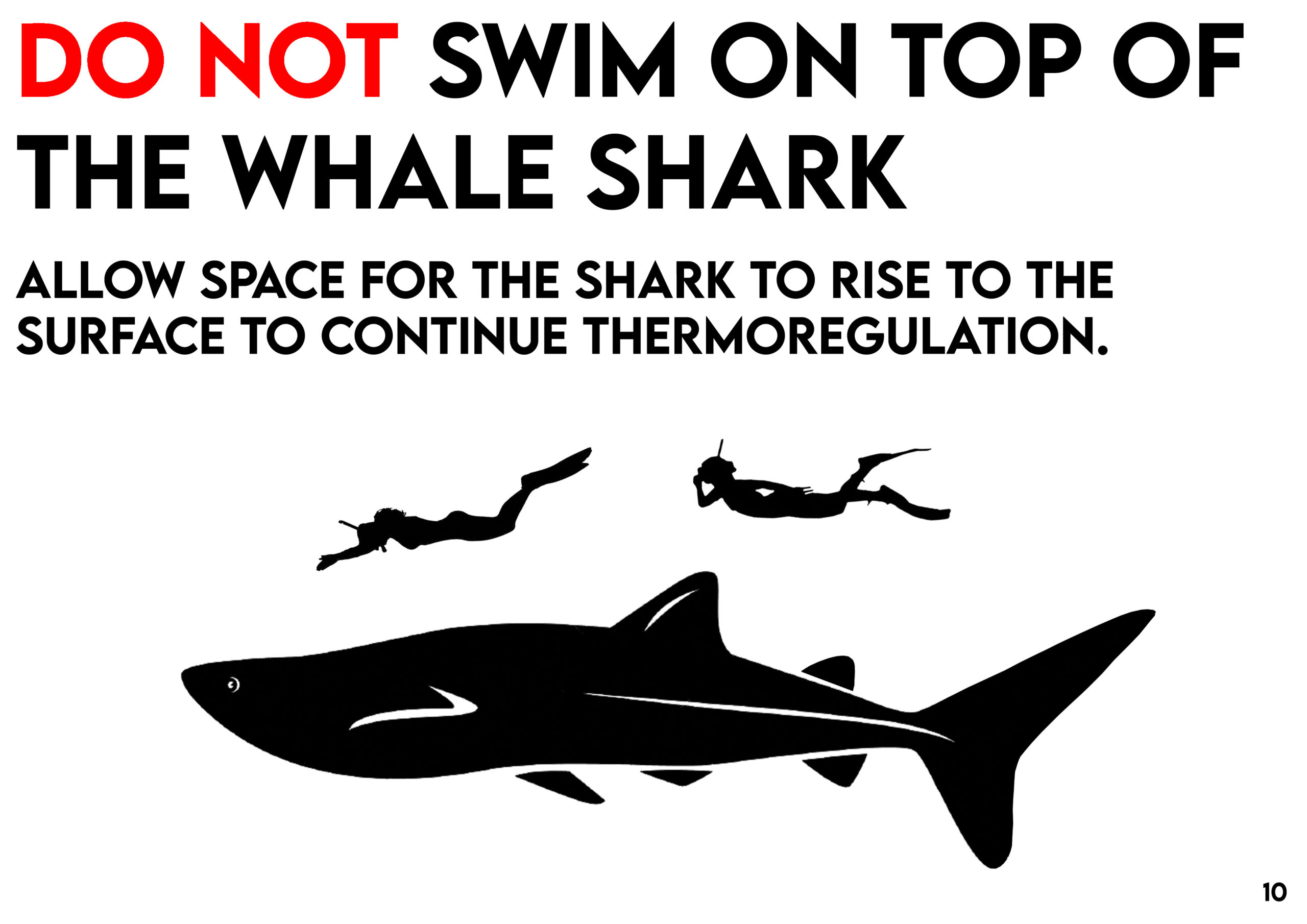

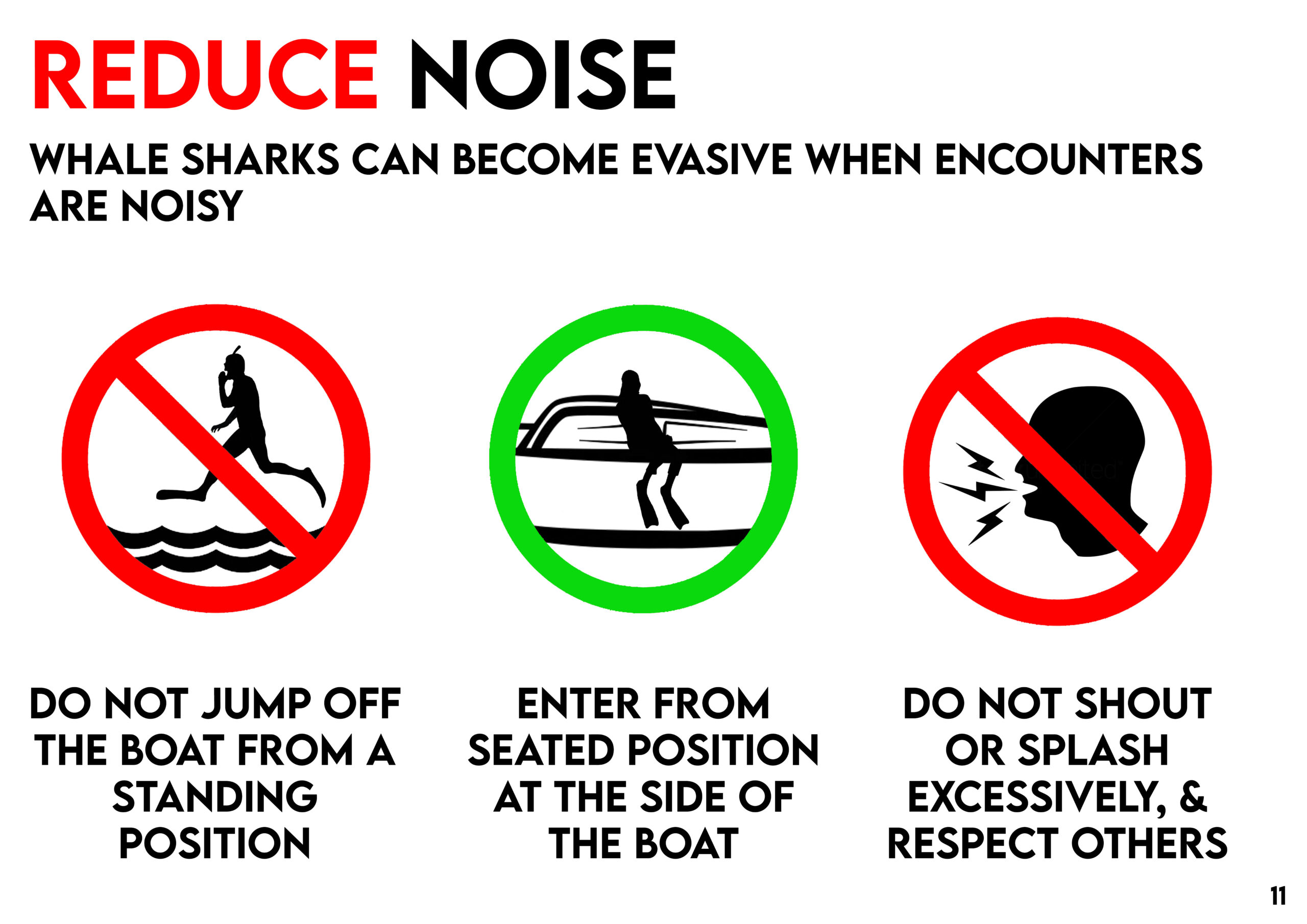
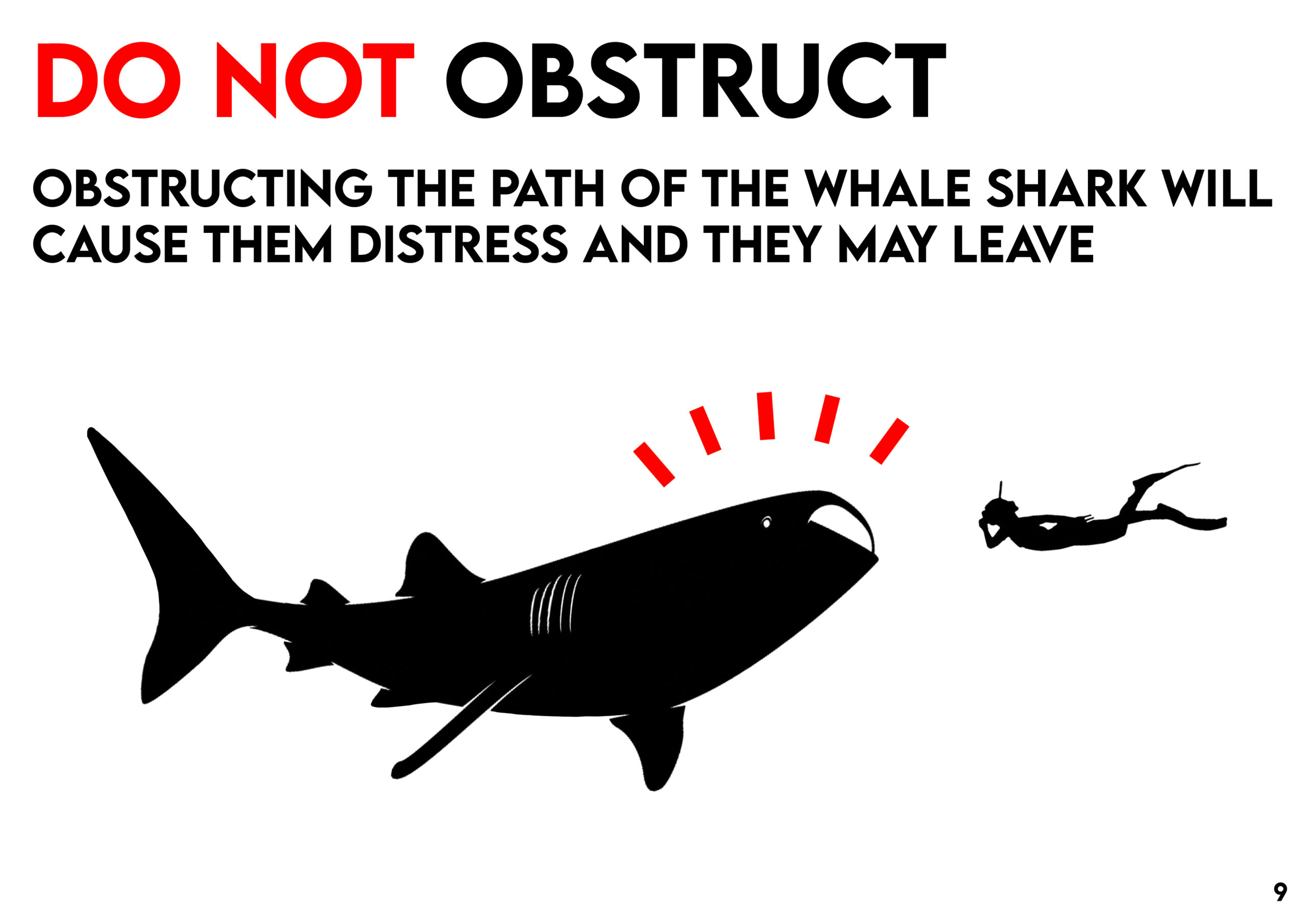
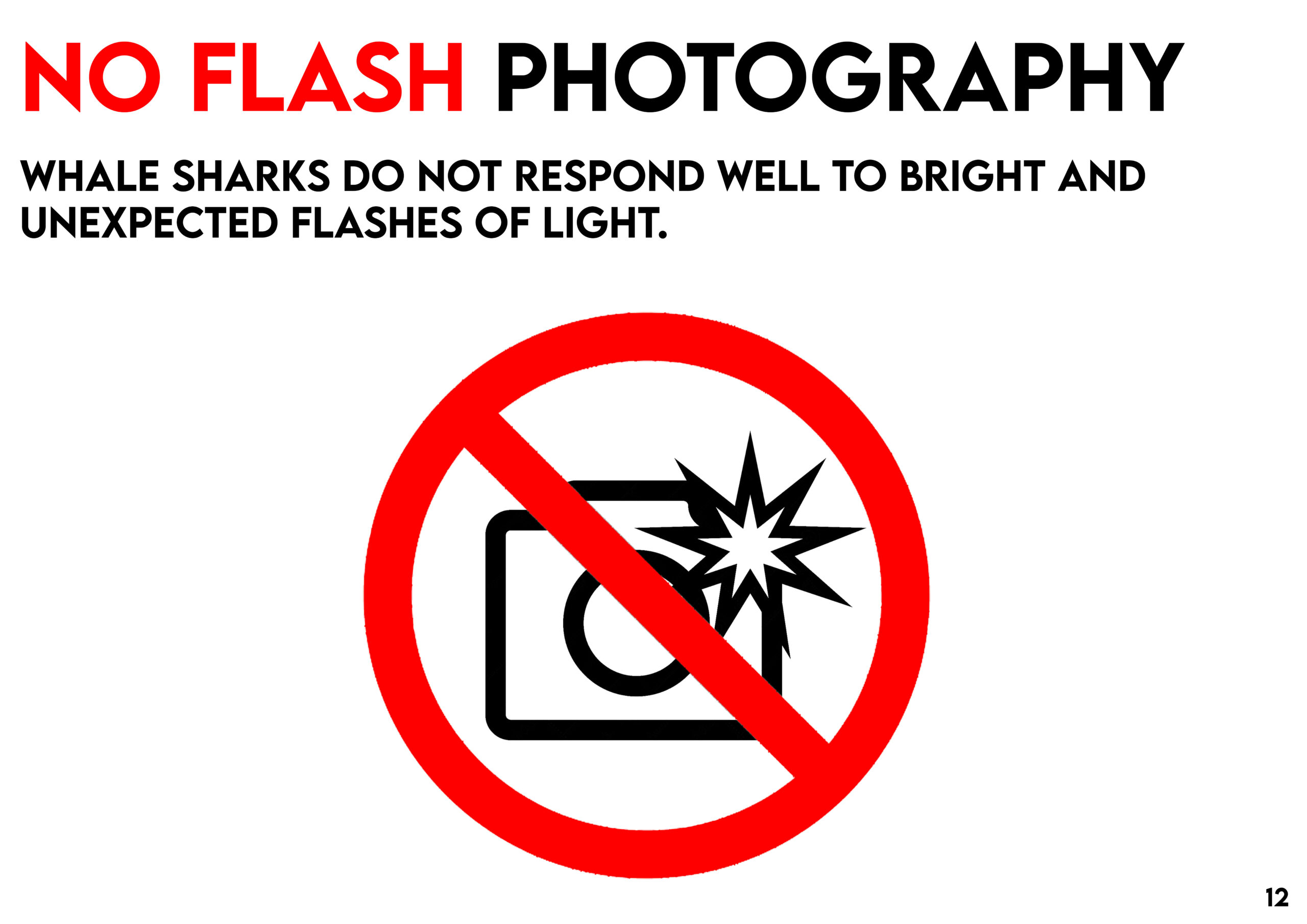
The code of conduct is based on years of experience and the collection of scientific data and offers the opportunity to enable tourism to interact with the animals without harming or disturbing them. However, the code of conduct can only be reliably adhered to if the number of people in the water is reduced or regulated, the tour operators inform their guests beforehand and put the well-being of the animals first. Because as long as the tour operators are under pressure to make it possible for their guests to encounter a whale shark and usually take as many people as possible with them at the same time in order to increase their income, the paying customer will be put above the well-being of the animals in case of doubt. Regulatory measures are urgently needed here by politicians.
Also in this regard, MWSRP is trying to stand up for whale sharks and use the data it has collected to convince Maldivian politicians of the enormous importance of protective measures. In recent years, fewer and fewer animals have been sighted. At the same time, there is a steady increase in the number of tour operators, which increases the pressure to offer customers a unique experience and in turn puts the individual animals under even more stress. But it’s not only the tourism of many countries and thus the local economy that depend on the preservation of whale sharks. The marine ecosystem also needs these animals.
Why are whale sharks important to the ecosystem?
- Whale sharks are filter feeders, which means that they filter their food out of the water while swimming with their mouths open. They feed mainly on plankton. For this reason, they play a crucial role in maintaining and regulating the plankton population. They also fertilize phytoplankton by bringing nutrients from the deep water to the surface, where they distribute them as feces.
- They also serve as a natural carbon sink. Due to their enormous size and their diet of plankton, whale sharks store a lot of carbon. When the animals die, they take the bound carbon with them to the deep sea, so that it remains on the seabed for many years. In this way, they play an important role in reducing carbon and thus combating climate change.
- Many smaller fish use whale sharks as a type of “transportation” near which they seek protection.
- They are also considered both an indicator and an umbrella species. The former means that the area in which they live is a productive habitat overall. They are an umbrella species because protecting the marine area for the whale shark (which is also a very popular shark species among people because it is considered beautiful with its spotted pattern and does not pose a threat to humans, which is why many people want to swim with it) also protects other smaller but important species that live in that habitat.
Even though some important data and facts about whale sharks have already been obtained, with research projects such as the MWSRP playing a key role, there are still large gaps in knowledge about the world’s largest fish, which can grow up to 18-20 meters. According to current knowledge, a whale shark can live up to 120 years, which is why it is assumed that it does not reach sexual maturity until around 25 years of age, although this fact is only an estimate. And apart from the fact that the sharks are ovoviviparous (the young hatch from eggs still inside the female’s body), the exact location, behavior and frequency of their reproduction are still a mystery. However, these are crucial facts to ensure the protection of whale sharks. Because only if the breeding grounds are protected the continued existence of whale sharks can be ensured.
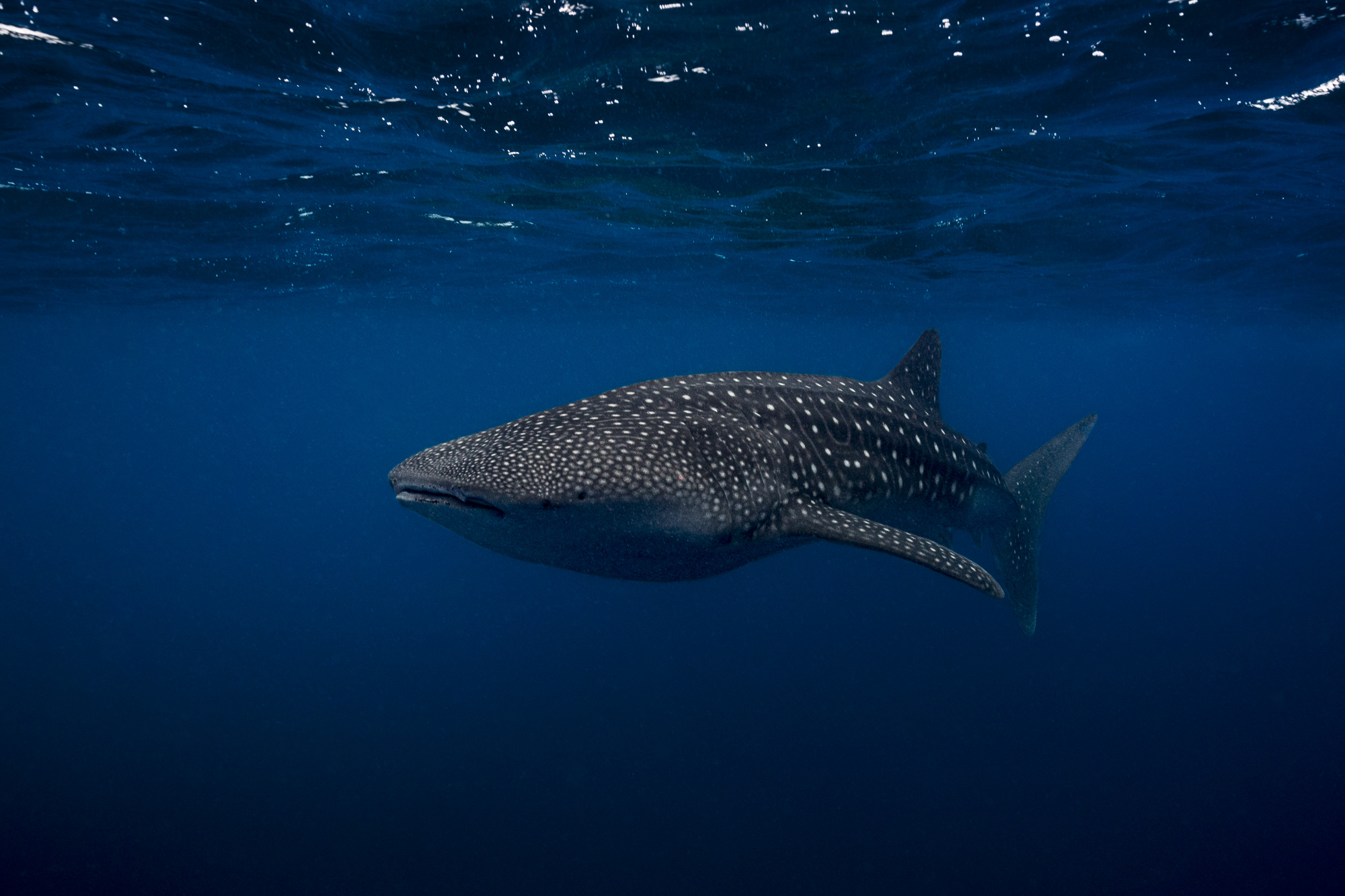
What threats do whale sharks face?
According to the IUCN (International Union for Conservation of Nature and Natural Resources) Red List of Threatened Species, the whale shark has been considered endangered worldwide since 2016. An overall decline of 63% has been recorded in the Indo-Pacific (which includes the Maldives) over the past 75 years. These figures are frightening and make it all the more clear that whale sharks urgently need our protection and how important programs like the MWSRP are.
What threatens the populations so much? By far the greatest enemy of whale sharks is humans. In some countries, the animals are still fished directly. However, they now end up as bycatch in fishing nets much more frequently.
Another threat is entanglement in plastic or fishing rope, which seriously injures or even strangles the animals. Small pieces of plastic, so-called microplastics, also pose a danger, even if research is still in its early stages. And the way the animals are treated in the tourism industry, as mentioned above, also plays a role in the issue. It is not just the harassment of the animals that is a problem. The boats that race too fast over the areas and destroy the animals’ dorsal fins in the process lead to serious injuries. It may seem harmless, but feeding the animals and attracting them with light is also worrying, as this disrupts their biorhythm, leads to increased stress and thus also affects their immune system.
What do we take away from the experience?
We not only gained an incredible amount of knowledge in the 10 days and were able to help collect data ourselves, but we also experienced first-hand what effects wrong or right behavior can have on the animals. We were incredibly lucky to be the only boat to spot a whale shark for miles around. So we slipped into the water as quietly as possible and approached the animal carefully. Everyone in our group kept a sufficient distance; no one swam directly in front of the animal and we were rewarded for that: the whale shark let us swim next to him for a whole 40 minutes. Our photographers’ hearts beat faster when we were able to take beautiful pictures of it. At the same time, we completely absorbed the moment and observed the animal’s behavior with calm and humility.
This is exactly how encounters with marine animals should always go! But that is only possible if we all do our part and through people like the MWSRP team, who fight every day to protect these gentle giants.
We can all do our part in different ways. It is important that if you have the desire to swim with whale sharks or other megafauna and would like to make it happen, you do good research beforehand and find the best providers. Among other things, you should make sure that the crew has in-depth knowledge, experienced guides are in the water with you and the animals are respected. Is there a code of conduct and is it explained in detail and taken seriously and adhered to? How big are the groups of people and how many people are in the water with the animals at the same time? Are facts about the behavior of the animals shared? How does the provider deal with the plastic issue? Are lots of small plastic bottles distributed, or is it pointed out that guests should bring refillable bottles? Read reviews and don’t be afraid to approach the organizer and ask questions about the process and the general conditions. Of course, there are other things we can all do in our everyday lives to live sustainably and protect ocean megafauna. You find more information about this on our “What you can do” page.
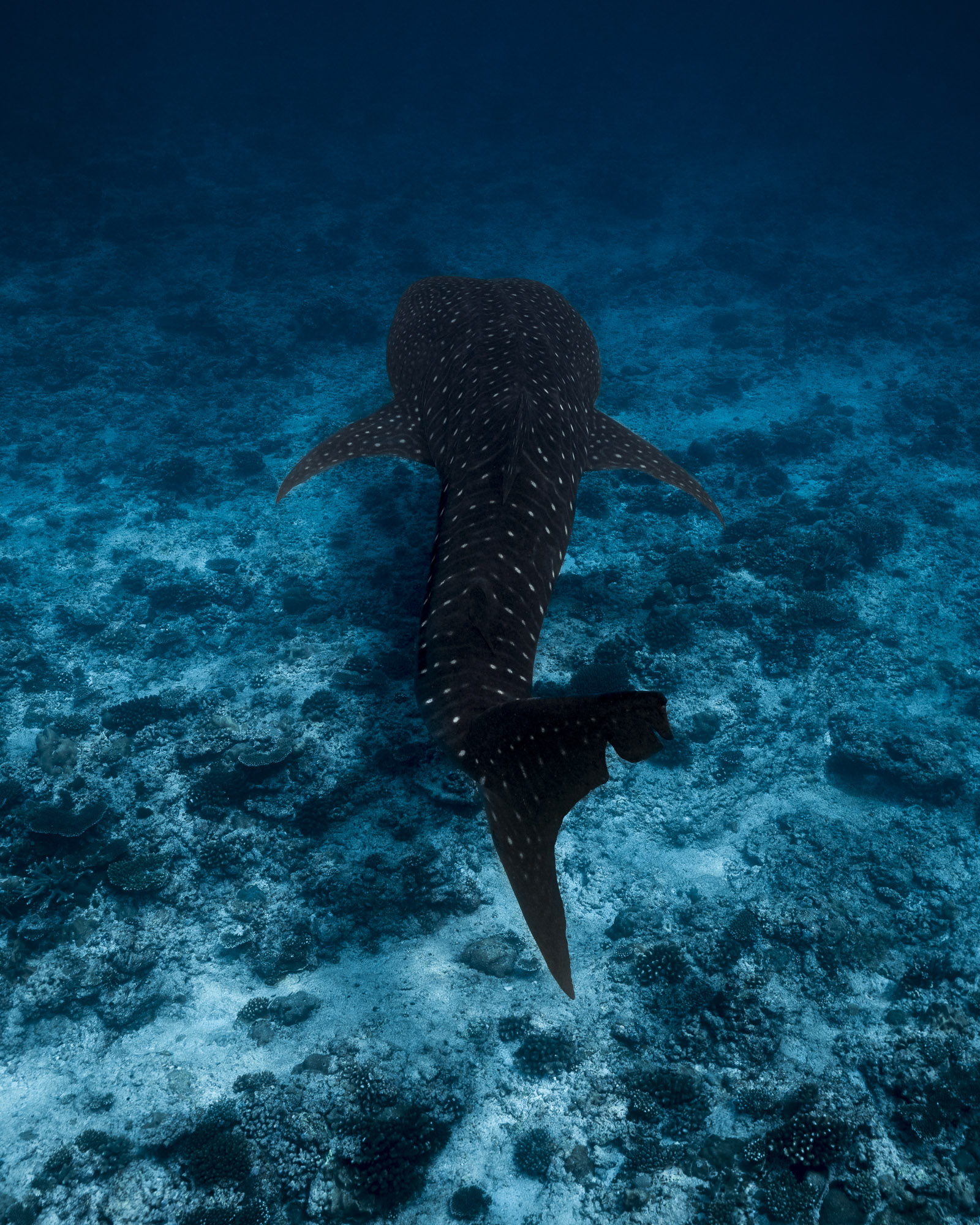
How we supported whale shark research on the Maldives and the MWSRP

How did we get into it?
Since we went diving for the first time, the sea has become our absolute favorite place and the underwater world has fascinated us more and more with every dive. It is therefore hardly surprising that most of our trips are diving trips. We have tried everything from day trips to liverboard tours. We have had very different experiences with the various tour operators. Some focused on fun, others were particularly focused on the safety of the divers and still others just wanted to “satisfy” as many tourists as possible in the shortest possible time. Of course, we welcome great importance to safety and there is nothing wrong with having fun while diving. But on most tours one aspect was often neglected: marine conservation!
We saw destroyed reefs, corals wrapped in fishing nets, sharks whose fins had been cut by boats and tourists who harass or even enthusiastically touch marine animals. All of this was rarely discussed on the tours. Floating plastic was all too often ignored instead of being collected. And hardly any operator talked about the fact that tourism can also be harmful to the dive sites if it’s done carelessly. In particularly bad cases, we even saw dive guides themselves intentionally scaring or harassing the marine animals.
Of course, there were also very good guides and most of them only have good intentions. However, these experiences made us want to do our diving trips differently and so we looked for alternatives to the usual/conventional tour operators.
When we finally came across the Maldives Whale Shark Research Programme (MWSRP), we knew straight away that this was exactly the kind of trip we were looking for.

What exactly is the MWSRP?
The research programme is about collecting data on whale sharks in the South Ari Marine Protected Area (SAMPA) and processing it scientifically, for example by conducting studies on long-term observations. SAMPA is a marine area along the South Ari Atoll in the Maldives that has been protected since 2009. The 42 km long area stretches from the north-western end of the reef off Rangali Island to the north-eastern end of Dhigurah Island. It has been known for years as a hotspot for whale shark sightings, as it is a kind of second kindergarten or recreational area for juvenile whale sharks.
As a result, MWSRP has made it its mission to identify and catalog the whale sharks found in SAMPA using photo ID and to record other relevant data and environmental factors when the animals are sighted (more on this below). Another very important aspect of their work is to strengthen conservation policy in the Maldives and to engage and teach local people and industry through education and outreach.

What were the days like as volunteers?
Part of the program is to give volunteers the opportunity to accompany them for 10 days, support them in their work and learn from them. That sounded like the jackpot to us. Not only do we have the chance to see the megafauna that we love, but we also have the chance to make a contribution to nature conservation and science. So we applied for April 2024 and could hardly believe our luck when we received positive feedback. We have never been so excited about a trip as we were about this one!
The big day of arrival came and it all started with us meeting the other volunteers at the airport. There we were met by Clara and Chloe, the two leaders of the tour. We went straight to a Maldivian boat, a so-called dhoni, which took us to our mother boat and made our way to the South Ari Atoll. A few minutes after we set off, the sea greeted us with a large pod of spinner dolphins, who put on a little show for us. The trip took about 6 hours. Since we only arrived after dark, the surprise of our new home for the coming days was even greater the next morning: We anchored right on the edge of the most beautiful reef we had seen up to that point. Crystal clear, turquoise water surrounded us and apart from a few very small islands in the distance, there was nothing but water around us.

On the first evening we received a briefing about the program and how the coming days would go. It quickly became clear that this was not just a fun event and that the days would be exhausting. Every morning at 7:30 a.m. there was breakfast and our working day began at 8:30 a.m. We went out to the SAMPA in our dhoni and there we drove up and down for the next 8-9 hours, constantly looking for whale sharks. Our group of volunteers consisted of 12 people. Half of the group always had to look out for the animals on the roof of the dhoni, while the other half could recover one floor below from the merciless heat of the sun. At lunchtime we usually cooled off with a snorkeling tour along the reef and ate lunch on the dhoni.
For the first few days, luck stayed away from us and apart from other marine life such as turtles or rays, whose coordinates we recorded, there were no sightings of whale sharks. In addition, we often collected plastic waste from the sea whenever we saw ghost nets or larger pieces of plastic. We also saw tour boats all the time and in large numbers. We encountered everything from diving schools to snorkeling trips to large liveaboards. And here too we recorded important data such as the coordinates, the number of people on them, whether they were racing over the reef and who the operators were. Because the presence of many vehicles on the water, how they behave and the simultaneous absence of whale sharks can also be a relevant statement for science in the marine reserve.
Our first whale shark – our first identification
It was only on the 4th day that luck was with us. We saw our first whale shark! We were in the group taking a break and resting, our eyes were about to close when we suddenly heard strong, insistent stamping of feet from above. Then the calls. A whale shark was spotted. And from one second to the next we were in motion. We quickly slipped into our clothes and grabbed our cameras. In the water we had to flap our fins vigorously to get to the animal. And one thing became immediately clear to us at that moment: even world-class swimmers can’t compete with these big fish if they want to – and we certainly can’t. For this reason, our encounter was rather short-lived. This is not uncommon: Most encounters with whale sharks only last a few minutes, so this was not unusual.
The primary goal of a sighting is to identify the animal. To do this, at least one side, preferably both, of the shark must be photographed. The section between the end of the side fin and the last gill is important. This photo is then uploaded to a database in the evening and the most distinctive points of the animal in the section are manually traced. The program then searches the database for exactly this pattern. Because: The dotted pattern of whale sharks is always unique, similar to our human fingerprints.
A pattern as unique as a fingerprint.

In particularly favorable circumstances, additional photos are taken from below (to determine the sex), from above and from the second side. However, the animal is the first priority. If it shows evasive or shy behavior, the additional photos are omitted. In particular, the shot from above may only be taken when the whale shark is already diving again.
In addition to identification, the program also deals with other relevant data that must be recorded. This means that after we have taken our photos and the whale shark has swum away, the coordinates of the sighting, the water temperature, wind strength and direction, the direction of the current and the visibility underwater must be recorded immediately. Further on, as many notes as possible are made about the animal’s behavior and the external circumstances.

In terms of behavior, a distinction is made between different feeding behaviors, relaxed swimming, curious, interactive, unnatural or evasive behavior, fast swimming and abrupt turns, tilting and retraction of the eyeballs. The last four behaviors in particular are to be interpreted negatively and mean that the animals feel uncomfortable or harassed. They are a clear sign that people should withdraw more in these situations in order to keep enough distance and thereby give the animal more space.

How does the work help to protect the animals?
For example, if several tour operators are on site at the same time and all of their guests want the chance to see the big fish, this can quickly lead to the guests getting too close to the animal. Unfortunately, it also happens again and again that uninformed people even try to touch the animals. This puts the whale sharks under enormous stress, as they urgently need the time at the surface to raise their body temperature again. Whale sharks can dive hundreds of meters deep and stay there for a long time, but they are dependent on returning close to the surface afterwards. This is because whale sharks are ectothermic, which means that their body temperature is roughly the same as the temperature of the water around them and they cannot regulate it themselves through internal physiological processes. This circumstance leads to lower energy consumption. So if the animals dive very deep, their body temperature also drops. In order to warm up again, they then have to swim close to the warmer surface in order to reach their thermal optimum again. If they are disturbed and then dive down too soon, this process is interrupted and causes stress for the animals.
For this reason, MWSRP has developed a code of conduct that they make available to all tour operators in the SAMPA region and that they also distribute via social media in order to reach operators and tourists worldwide.
According to the code of conduct, you should:
- never touch the animals (and generally all living creatures in the sea)
- always keep at least 3 meters away from the body and 4 meters from the tail fin
- do not swim in front of them or above them (only above them when the animals have already dived again of their own accord)
- do not use flash when photographing the animals and avoid loud noises as much as possible
You find more information on the page of MWSRP about sustainable tourism.






The code of conduct is based on years of experience and the collection of scientific data and offers the opportunity to enable tourism to interact with the animals without harming or disturbing them. However, the code of conduct can only be reliably adhered to if the number of people in the water is reduced or regulated, the tour operators inform their guests beforehand and put the well-being of the animals first. Because as long as the tour operators are under pressure to make it possible for their guests to encounter a whale shark and usually take as many people as possible with them at the same time in order to increase their income, the paying customer will be put above the well-being of the animals in case of doubt. Regulatory measures are urgently needed here by politicians.
Also in this regard, MWSRP is trying to stand up for whale sharks and use the data it has collected to convince Maldivian politicians of the enormous importance of protective measures. In recent years, fewer and fewer animals have been sighted. At the same time, there is a steady increase in the number of tour operators, which increases the pressure to offer customers a unique experience and in turn puts the individual animals under even more stress. But it’s not only the tourism of many countries and thus the local economy that depend on the preservation of whale sharks.
Why are whale sharks important to the ecosystem?
- Whale sharks are filter feeders, which means that they filter their food out of the water while swimming with their mouths open. They feed mainly on plankton. For this reason, they play a crucial role in maintaining and regulating the plankton population. They also fertilize phytoplankton by bringing nutrients from the deep water to the surface, where they distribute them as feces.
- They also serve as a natural carbon sink. Due to their enormous size and their diet of plankton, whale sharks store a lot of carbon. When the animals die, they take the bound carbon with them to the deep sea, so that it remains on the seabed for many years. In this way, they play an important role in reducing carbon and thus combating climate change.
- Many smaller fish use whale sharks as a type of “transportation” near which they seek protection.
- They are also considered both an indicator and an umbrella species. The former means that the area in which they live is a productive habitat overall. They are an umbrella species because protecting the marine area for the whale shark (which is also a very popular shark species among people because it is considered beautiful with its spotted pattern and does not pose a threat to humans, which is why many people want to swim with it) also protects other smaller but important species that live in that habitat.

Even though some important data and facts about whale sharks have already been obtained, with research projects such as the MWSRP playing a key role, there are still large gaps in knowledge about the world’s largest fish, which can grow up to 18-20 meters. According to current knowledge, a whale shark can live up to 120 years, which is why it is assumed that it does not reach sexual maturity until around 25 years of age, although this fact is only an estimate. And apart from the fact that the sharks are ovoviviparous (the young hatch from eggs still inside the female’s body), the exact location, behavior and frequency of their reproduction are still a mystery. However, these are crucial facts to ensure the protection of whale sharks. Because only if the breeding grounds are protected the continued existence of whale sharks can be ensured.
What threats do whale sharks face?
According to the IUCN (International Union for Conservation of Nature and Natural Resources) Red List of Threatened Species, the whale shark has been considered endangered worldwide since 2016. An overall decline of 63% has been recorded in the Indo-Pacific (which includes the Maldives) over the past 75 years. These figures are frightening and make it all the more clear that whale sharks urgently need our protection and how important programs like the MWSRP are.
What threatens the populations so much? By far the greatest enemy of whale sharks is humans. In some countries, the animals are still fished directly. However, they now end up as bycatch in fishing nets much more frequently.
Another threat is entanglement in plastic or fishing rope, which seriously injures or even strangles the animals. Small pieces of plastic, so-called microplastics, also pose a danger, even if research is still in its early stages. And the way the animals are treated in the tourism industry, as mentioned above, also plays a role in the issue. It is not just the harassment of the animals that is a problem. The boats that race too fast over the areas and destroy the animals’ dorsal fins in the process lead to serious injuries. It may seem harmless, but feeding the animals and attracting them with light is also worrying, as this disrupts their biorhythm, leads to increased stress and thus also affects their immune system.
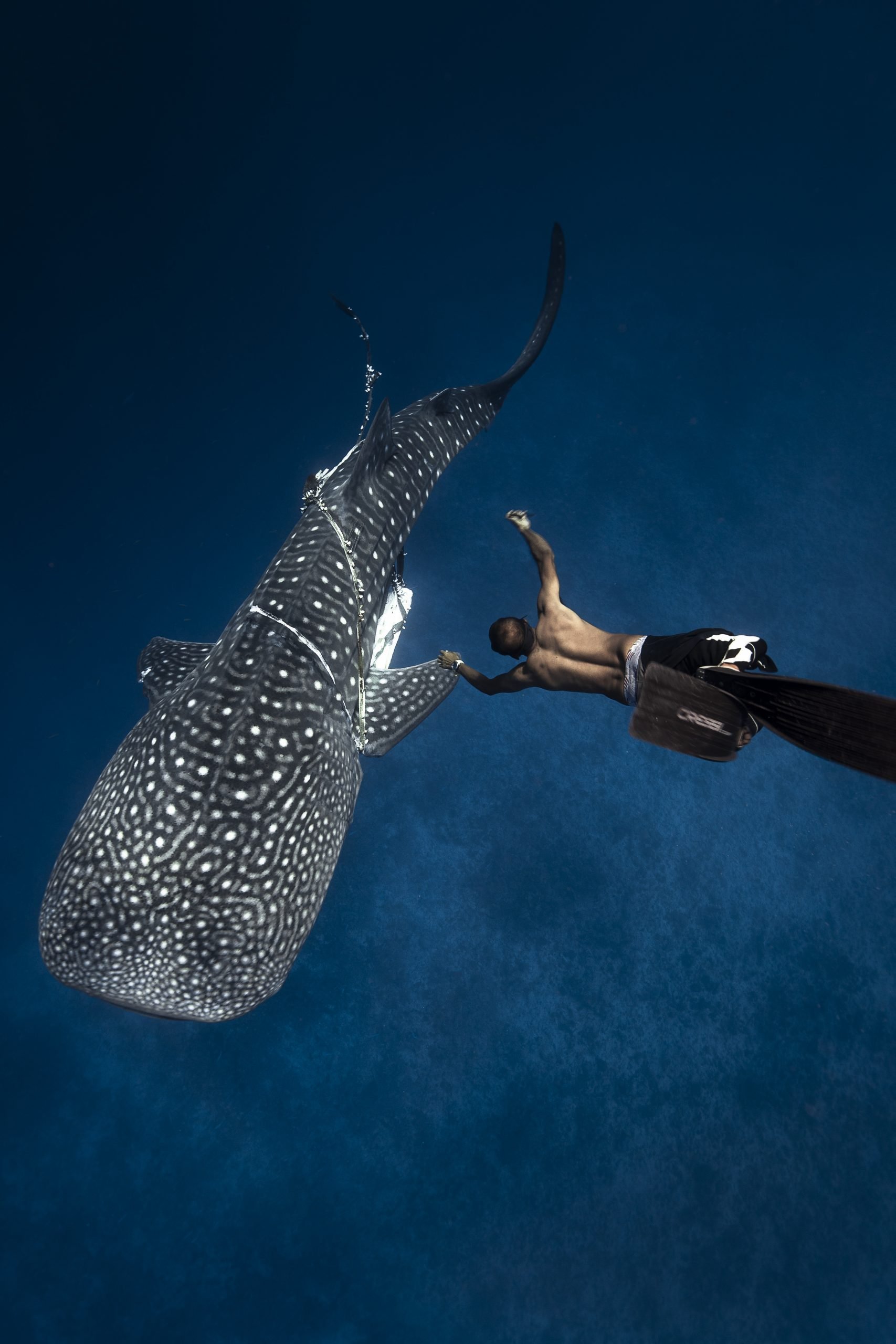
What do we take away from the experience?
We not only gained an incredible amount of knowledge in the 10 days and were able to help collect data ourselves, but we also experienced first-hand what effects wrong or right behavior can have on the animals. We were incredibly lucky to be the only boat to spot a whale shark for miles around. So we slipped into the water as quietly as possible and approached the animal carefully. Everyone in our group kept a sufficient distance; no one swam directly in front of the animal and we were rewarded for that: the whale shark let us swim next to him for a whole 40 minutes. Our photographers’ hearts beat faster when we were able to take beautiful pictures of it. At the same time, we completely absorbed the moment and observed the animal’s behavior with calm and humility.
This is exactly how encounters with marine animals should always go! But that is only possible if we all do our part and through people like the MWSRP team, who fight every day to protect these gentle giants.
We can all do our part in different ways. It is important that if you have the desire to swim with whale sharks or other megafauna and would like to make it happen, you do good research beforehand and find the best providers. Among other things, you should make sure that the crew has in-depth knowledge, experienced guides are in the water with you and the animals are respected. Is there a code of conduct and is it explained in detail and taken seriously and adhered to? How big are the groups of people and how many people are in the water with the animals at the same time? Are facts about the behavior of the animals shared? How does the provider deal with the plastic issue? Are lots of small plastic bottles distributed, or is it pointed out that guests should bring refillable bottles? Read reviews and don’t be afraid to approach the organizer and ask questions about the process and the general conditions. Of course, there are other things we can all do in our everyday lives to live sustainably and protect ocean megafauna. You find more information about this on our “What you can do” page.

